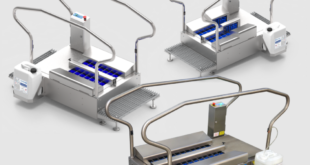Martin Gadsby looks at how companies can use PAT to address the inherent challenges of solid mixing and drive their competitiveness in a challenging marketplace
Solid mixing is one of the most common and challenging processes in the chemical, pharmaceutical, food, plastic and rubber production industries. When processing two or more particulate materials, manufacturers need to address the different properties of the substances involved to obtain a distribution that is uniform. Smart, automated process control strategies based on Process Analytical Technology (PAT) offer a key opportunity to overcome agglomeration and segregation to achieve blend homogeneity.
In an ideal blend, the probability of finding a particle of any component is the same in all locations and equal to the proportion of that component in the bulk material. This can be easily achieved when all particulate, granular or powdered components have the same physical properties, such as particle size, density and shape. Also, it is necessary for the materials to be able to withstand energy- and time-intensive mixing operations. However, solid blends are typically made of components with different characteristics and typically feature raw material variability. Therefore, the materials are affected in different ways by the energy and forces applied during the mixing operations.
As a result, preferential clustering and movement of particles within regions of the powder/granule bed or mixer can occur. These lead to agglomeration and segregation, which compromise uniformity and end product quality.
Particle attrition and electrostatic accumulation are other undesirable phenomena that can also occur. This lack of homogeneous blending is a leading cause of quality variations, resulting in wastage and reworks.
Adding to the mix
Segregation and disturbance of the powder/granule bed, posed by a sampling thief, make it difficult for manufacturers to conduct effective sampling and develop an in-depth understanding that can help to define the optimum process conditions. As such, common thief sampling is difficult to reproduce, and the collection of segregated, non-representative samples can lead to bias in results.
Furthermore, off-line analytical methods are labor-intensive and greatly increase downtime plus processing time, as there is often a long delay from when the blenders/mixers are stopped to the time the test results are received. Besides, operators and technicians can potentially be exposed to hazardous chemicals and fine particles while collecting samples.
To avoid these issues, manufacturers tend to use pre-set processing conditions that favor overprocessing, increasing processing times and energy usage without greatly improving product quality. Overmixing imparts excess energy to the blend that can lead to quality failure, as physicochemical attributes may be altered. In some cases, overblending can result in constituent separation and heterogeneity.
Ditching pre-set processing parameters
The only strategy to deliver products of consistently high quality involves having an immediate and responsive on-line overview of the blend attributes and how they vary during the different mixing phases. This can be achieved by digitalising these activities with PAT-driven real-time, automated process control systems.
This type of framework takes advantage of real-time analyzers connected to mixers and blenders that measure the raw materials’ critical material attributes (CMAs) and the mixture’s critical quality attributes (CQAs). The data from these is fed to a PAT knowledge management software, such as synTQ, which displays the information in an intuitive format for operators. At the same time, accurate process optimisation and multivariate models can be created to modulate process parameters and monitor blend homogeneity. For some products in batch blenders, these may simply consist of moving block standard deviation or F testing functions.
In effect, once validated, these models and methods are executed inside the PAT knowledge manager, while mixing occurs, providing a real-time quality attribute window into the process. This information can then be used to either automatically control the process (in the case of continuous manufacturing) or trigger the completion of the process (in the case of batch blending). As a result, manufacturers avoid under- and over-processing, obtaining products of consistent, high quality with minimal production times and energy usage, as well as low waste and rework rates.
The ultimate PAT control for a batch blender is usually just the timely stopping of the process when the blend is optimised. However, PAT control of continuous blenders can control parameters such as blender rotational speed and raw material feed rate to optimise blend uniformity.
Delivering key instrumentation
In order to deliver an advanced setup for manufacturers in different industries, Optimal and its instrumentation partner, VIAVI, developed a data-driven, intelligent use case for detecting the end-point of blending in V-shape mixers.
The system leverages VIAVI MicroNIR PAT-W near-infrared (NIR) spectrometer, an accurate, compact and rugged analyser that can be easily added to any processing unit. The instrument conducts extremely fast, highly reproducible and non-invasive analyses of the CQAs of the materials being processed while eliminating the risk of contamination during sampling. The NIR spectra, acquired in real time, are immediately sent to Optimal’s synTQ software, which analyses the data and determines blend uniformity. Once the optimum CQAs are achieved, synTQ sends a stop signal to the blender, preventing overprocessing.
The system is also exceptionally easy to install, configure and start-up. As monitoring and control do not usually require a multivariate calibration model to determine blend uniformity and process endpoint, implementation can be completed in less than two days. As a result, manufacturers can benefit from a quick return on investment (ROI) and maximum uptime.
Controlling mixing conditions
synTQ was also a key asset when the GEA-NUS Pharmaceutical Processing Research Laboratory at the National University of Singapore wanted to develop an innovative automated solid mixing system to process active pharmaceutical ingredients (APIs) and excipients. The solution was designed to mitigate the effect of particle size distribution variability in excipients while optimizing mixing parameters (speed and time) to achieve blend uniformity.
The setup consists of a double cone blender equipped with VIAVI MicroNIR PAT-W sensor. synTQ gathers the spectra, which are used by chemometric models hosted in the software to predict the particle size distribution of excipients and the concentration of APIs in the blend. The predicted particle size distribution results support feedforward control of mixing speed, as they are sent to a process optimization algorithm which is also hosted in synTQ. This encodes the process model and promptly determines the optimal mixing speed.
The API concentration predicted by the chemometric model is used by an endpoint detection/decision algorithm for feedback control of mixing time. This is configured using statistical and logic routines to determine when the ideal concentration is achieved and blending should stop. Both the feedforward and feedback control signals are relayed to a control hardware that adjusts the blender’s operating parameters.
Conclusions
A PAT system incorporating synTQ can address the inherent challenges of solid mixing, providing manufacturers the tools to effectively deliver consistent, high quality products. In addition, this framework can help deliver innovative setups to automate and futureproof these operations, supporting digital transformation strategies that drive up competitiveness.
Martin Gadsby is VP at Optimal Industrial Technologies.
 Engineer News Network The ultimate online news and information resource for today’s engineer
Engineer News Network The ultimate online news and information resource for today’s engineer




